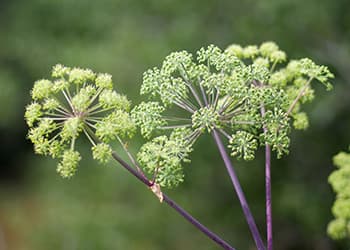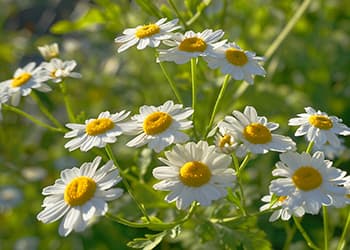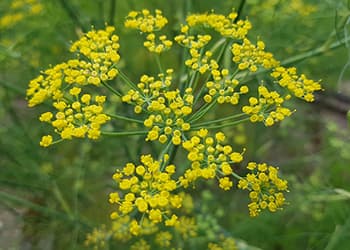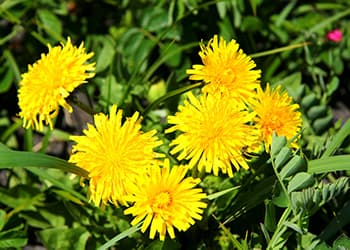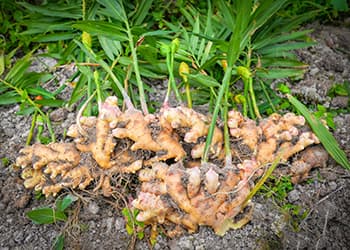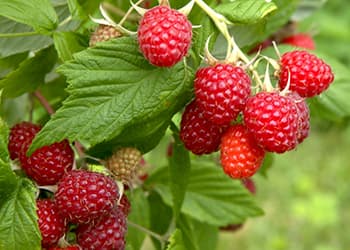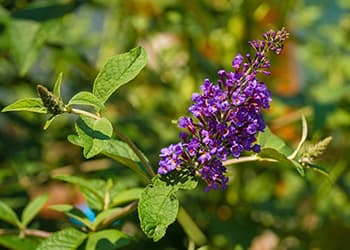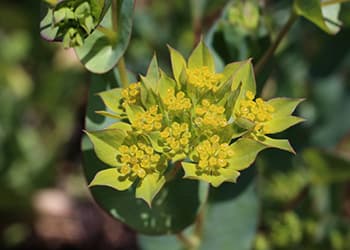Menstrual cycles often bring a wide variety of uncomfortable symptoms: cramps, bloating, headaches, and more. And that’s if they come regularly, or aren’t very heavy! Luckily, outside of wearing Reign natural period pads, the natural world is rife with medicinal herbs that can help ease the worst of your period pain, regulate your cycle, and keep you feeling your best.
Here are 10 herbs that can help naturally soothe your menstrual cycle symptoms:
1. Female Ginseng (Angelica sinensis)
Female ginseng, also known as dong quai, has a small white flower and rope-like brown tubers for roots. Though commonly referred to as ginseng with the appearance to match, it’s not actually in the ginseng family! It belongs to the flowering Apiaceae family.
A commonly-used root in Chinese medicine, female ginseng is used to both circulate and replenish the blood. It keeps blood from stagnating in the body during your period, and helps nourish the body once the menstrual cycle is finished. It can also fight inflammation and has an analgesic, or numbing effect, for pain, like aspirin.
Use: Take female ginseng to ease cramps and increase energy starting the day before your period begins. Ingest a few drops of a female ginseng tincture, or steep the roots in hot water with lemon, as a tea. You can also buy commercial teas that include female ginseng.
2. Chamomile (Matricaria chamomilla)
Chamomile is a super-herb of the western world. Its flower looks like a tiny, white daisy, and when dried, it can be used in a variety of ways for a range of ailments! You may be used to taking chamomile before bedtime or to help a cold, but it can also be a powerful tool for period pain.
Chamomile helps relax the body through its anti-spasmodic properties, which can be incredibly helpful in reducing cramps. It also stimulates the nervous system, helping to offset or reduce the “moodiness” of a menstrual cycle by moderating the brain’s production of dopamine and serotonin. This can also help with headaches brought on by hormonal changes!
Use: Take chamomile to ease cramps and boost your mood. Chamomile is best drunk as a tea. Steep the dried flowers in hot water, or combine with other helpful herbs like fennel, cinnamon, or dandelion root.
I got my seeds from the Medicinal Garden Kit, so I’d never have to worry again about my dried herbs supply.
3. Fennel (Foeniculum vulgare)
Fennel, the common kitchen vegetable with a leafy green top and white bulbous bottom, is a hidden gem when it comes to fighting period pain. It’s been studied as a remedy to everything, from mild cramps to severe dysmenorrhea.
For women who find that heat from a heating pad or hot bath often eases their cramps, fennel is a great addition to your repertoire of relief. Fennel has been shown to lower levels of hormones known as prostaglandins, which inflame the uterus, so it has a similar effect to Midol or Ibuprofen.
Use: Take fennel for cramps or other pain associated with your menstrual cycle. Include dried fennel seeds in your tea, take powdered fennel extract in supplements, or swallow a tincture of fennel as soon as symptoms start.
4. Dandelion (Taraxacum officinale)
You might recognize dandelion as the bright yellow flower that transforms into a puffball once it’s gone to seed, but it’s also a powerful medicinal plant!
Dandelion can help ease fluid retention by encouraging your body to get rid of excess water. This is particularly important for people who are prone to bloating, especially in the days before menstruation begins.
Use: Take dandelion for bloat and to help ease cramps. Dandelion is easy to brew in a tea, especially in combination with other herbs, or a tincture can be taken a few days before your period.
5. Ginger (Zingiber officinale)
Ginger, the yellow root common in grocery stores, is most known for its anti-bacterial and nausea-fighting power. But it can also be an important part of soothing period pain.
Ginger is another plant that suppresses prostaglandins, so it will help soothe the uterus while it contracts to shed the uterine lining. Additionally, ginger is a helpful plant for people who suffer from indigestion or difficult bowel movements during their menstrual cycles.
Use: Take ginger for period cramps, nausea, indigestion, or loose stool. It’s best brewed fresh as a tea with hot water and lemon, but powdered ginger capsules are often available in local health food stores too.
6. Cinnamon bark (Cinnamomum cassia)
If you only associate cinnamon with the warm scent of the holidays, think again! Cinnamon bark, also known as cassia bark, is closely related to “true cinnamon” and does way more than just flavor your favorite treats.
Cinnamon bark has impressive anti-inflammatory properties that help ease cramping. It can also help ease symptoms of nausea for people who struggle with upset stomachs during their menstrual cycles.
Use: Take cinnamon bark for period cramps or nausea. Make sure you find cinnamon bark (not cinnamon sticks) to make the most of this powerful plant, then steep the bark in hot water or your favorite tea concoction. You may also find powdered cinnamon bark in capsules that can be taken daily to ease symptoms.
7. Raspberry Leaf (Rubus idaeus)
Raspberries, the thorny and vining plant with small red fruits, are a delicious summertime snack. But they also have a secret power hidden in their leaves: they can help your body regulate and ease your menstrual cycle!
Raspberry leaf is high in magnesium and other plant compounds that can help ease the muscles in your pelvic floor during your period, making cramps less painful. Some women also report that regular use of raspberry leaves helps manage the predictability of their cycle, and lessen blood flow for women who have very heavy periods.
Use: Take raspberry leaves to ease cramps and manage irregular or heavy periods. Raspberry leaf tea is the most common application, and can be steeped in hot water with lemon or bought in commercial teas. Drink every day for best results.
8. Chasteberry (Vitex agnus-castus)
Despite their name, chasteberries look more like little peppercorns and grow on deciduous trees that bloom with violet flowers, but don’t let their small size discourage you. They are an incredible PMS-symptom fighting plant!
If you experience mood swings, bloating, irritability, and headaches before your period even begins, chasteberries might be just the thing you need. Chasteberries promote the production of progesterone, which helps balance out the spike in estrogen that happens near your period. That means that many of the symptoms associated with hormonal shifts, like moodiness or headaches, can be eased with chasteberry.
Use: Take chasteberry for mood swings, headaches, irritability, and bloat. Chasteberries can be made into a tincture, added into tea, or found as a supplement in pill form, and should be taken as soon as symptoms start before your menstrual cycle.
9. Bupleurum (Bupleurum falcatum)
Bupleurum, also known as thorow wax, is a shrub with small globes of yellow flowers. Used primarily in Chinese medicine, it’s thought to help increase liver function and thin the blood.
When it comes to period pain, though, bupleurum helps manage symptoms that are associated with a spike in estrogen like irritability, moodiness, or headaches. Because it supports the liver, bupleurum makes it easier for your body to process the excess estrogen being produced and so symptoms are less severe. It’s also thought to help cramps and muscle aches.
Use: Take bupleurum for mood swings, headaches, irritability, and cramps or muscle aches. It’s often found as a tincture or essential oil that can be added to tea or drunk in water, but the dried flower can also be steeped in hot water as a tea.
10. Safflower (Carthamus tinctorius)
Safflower, easily identified by its vibrant yellow, orange or red flower, is more than just beautiful—it also has important medicinal properties. In Chinese medicine, safflower is another plant that is thought to promote blood flow, which is useful during a menstrual cycle.
Because it helps stimulate the body’s circulatory system, it’s an especially important herb for people who experience very heavy clotting during their menstrual cycle or irregularity of their period. Safflower also has anti-inflammatory effects on the body, so it can help ease period pain as well.
Use: Take safflower to regulate the menstrual cycle, decrease flow, and ease cramps. Safflower is a beautiful addition to brewed teas, and can also be found as a tincture to be taken with water.
Having a monthly menstrual cycle isn’t always easy, but it can be much more manageable with the abundant gifts of nature. From chasteberry to safflower, herbs are here to help.
Drink an herbal tea, seek rest, and make yourself comfortable! Taking any of the herbs listed above will put you well on your way to a period with less pain.
~ Source: The Lost Herbs (Maddie Loeffler)


